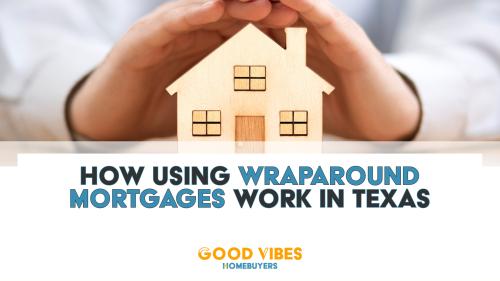
Many Texas homeowners believe that if a house has a mortgage, it cannot be sold without first paying off that mortgage. This is simply not true! Highly effective, surprisingly profitable, and perfectly legal ways exist that allow homeowners to sell a house without paying off the existing loan. 1 way is using what’s called a “wrap around mortgage”, which is often referred to simply as a “wrap”. This article will help you wrap your mind around the fundamental components of a wraparound mortgage, the situations for which they are most suited, and it details how homeowners in Texas can sell their house using the wrap around mortgage technique.
What’s in it for you
Selling a house through a wrap around mortgage means using a creative form of owner financing whereby the seller keeps the existing mortgage in place and creates a new, non-cash loan (the “wrap loan”) for the buyer that wraps around and is subordinate to the original mortgage (the “wrapped loan”). At closing, the buyer signs a promissory note which sets out the terms and payment plan of the wraparound mortgage, and, as security, the buyer signs a deed of trust in favor of the seller which allows them to foreclose and take back the house if the buyer defaults. The buyer-borrower then, like a conventional mortgage, makes monthly payments to the seller who continues making monthly payments on the original mortgage (another option is for the buyer-borrower to make mortgage payments directly to both the seller and original mortgage company). In short, using a wrap around mortgage to sell a house in Texas is like a conventional sale, except for 3 differences that are profitable for sellers:
In lieu of explaining the mortgage wraparound home sale process, we find it best to play out mortgage wraps with a recent real-life example of a homeowner who figured out how to sell a Texas home using a wraparound mortgage to GVH:
Seller Stella wants to sell her home for $200,000, investor Buyer Birdie wants to buy the home for $200,000, and she’ll even agree to a 10% ($20,000) down payment, provided Seller Stella extends a non-cash credit through a wrap around mortgage for $180,000. Seller Stella reviews the terms of her existing mortgage and sees that it has a 5% interest rate and a principal balance of $120,000 so she agrees to sell her home through a wraparound mortgage to investor Buyer Birdie for $200,000 and she’ll extend $180,000 in credit at 8% interest.
As a result, wrap mortgage investor Buyer Birdie pays Seller Stella a monthly principal and interest payment of $1,320.78 on her 8%, $180,000 wrap loan. Seller Stella’s existing mortgage payment is just $644.19 so Seller Stella keeps the difference ($676.59) between her existing mortgage payment and investor Buyer Birdie’s monthly wraparound mortgage payment. More astonishing is that Seller Stella extended just a $60,000 non-cash credit by using the wrap around mortgage technique and therefore her effective interest rate is earning a 13.53% return ($676.59 x 12 months) = ($8,119.08) / ($60,000).
Depending on your home’s equity position, Texans interested in selling to a we buy houses wrap around mortgage company like GVH, most often have the power to choose 2 of 3 variables: (1) High sale price, (2) high down payment, and (3) high monthly payment. For example, central Texas homeowners can often use a home mortgage wraparound to sell and get the highest possible sale price and to receive a high down payment. In so doing, the wrap around mortgage monthly payment a seller receives would likely then be reduced. Conversely, a high monthly payment and high sale price would likely limit the down payment. The bottom line is these 3 variables are not exclusive and therefore sellers can most often choose any 2.
The number 1 reason Texas homeowners sell a house via wraparound financing is that Good Vibes Homebuyers can pay market value, which is critical during a cool housing market or for homes with low equity. Moreover, wrap around financed home sales reduce transactional costs meaning that sellers pay zero closing expenses and realtor fees, GVH’s closing costs are less, and we pass those cost savings onto you. Other reasons homeowners sell houses through a wrap-around transaction include situations where they want (a) to earn passive income, (b) to sell without having to make and pay-out-of-pocket for repairs, (c) to eliminate bank approvals and contingencies, (d) to negotiate terms (e.g., interest rate spread, sale price) that are superior to a traditional sale, and (e) a free, quick, and simple closing.
Knowledge is power and at Good Vibes Homebuyers we believe that Texas homeowners should have the information necessary for making an informed decision. To that end, no matter if you sell a home via mortgage wrap, for all-cash, subject-to, FSBO, or the traditional way, each has their pros and cons, and selling a house while keeping the existing mortgage in-place is no different. So, what are the advantages and disadvantages of using a wrap around mortgage to sell a home in Texas?
a. Sell for fair market value: With our wrap mortgage offers, GVH can pay fair market value for homes within our central Texas service area. Here’s how: (i) bank financing costs are avoided, (ii) consumer loan interest rates are superior to investor loan interest rates, and (iii) realtor fees are eliminated. These 3 costs savings are passed onto Texas sellers who use wrap around mortgages in the form of a higher sale price.
b. Monthly income: Homeowners who sell a home without paying off the mortgage receive predictable passive cash flow every month (unless selling by a “mirror wrap”).
c. Higher return: Sellers who opt for a mortgage wrap transaction often pocket the difference between the existing mortgage’s interest rate and the interest rate of the wrap around mortgage loan. Just as neat, a seller’s return is amplified because the wraparound loan is for just a fraction of the total loan, yet sellers earn interest on the amount of both loans.
d. No banks and bank hassles: You already went through the bank inspection, appraisal, underwriting, and survey process when buying your home so there is no need to repeat these time-consuming, costly, and uncertain steps.
e. Quick and easy 5-day close: Sellers who prefer consistent and regular passive income or who want a speedy closing can use wrap around mortgage financing to sell a home in as little as 5-days with GVH.
f. Control: Sellers-lenders can sell a home’s wrap around mortgage promissory note and deed of trust to anyone else at any time and for a profit.
g. Even more control: If GVH defaults on its wrap around mortgage loan, Texas home sellers can foreclose on the home and sell again via the wrapped mortgage home sale process (GVH guarantees all payments will be made on time and paid in full). Even better, the house would have likely experienced significant appreciation and sellers get to keep the down payment and all monthly payments.
a. Foreclosure is a process: Since selling a home via wraparound mortgage involves sellers extending non-cash credit for the wrap mortgage, if the buyer were to default, the seller would have to go through the foreclosure process in order to take back the home.
b. Proceeds are spread out: Homeowners who use a mortgage wrap to sell their central Texas house are using a creative form of financing and therefore, only a negotiated percentage of the total sale price is received at closing.
c. The bank could call the mortgage due: Although we’ve never heard of this happening in Texas, every mortgage includes a standard clause that gives mortgage servicers the right, but not the obligation, to demand full payment of the mortgage upon a change in ownership. This may seem quite scary, and it does present a (very) minor risk, but we’ll reiterate – we’ve never seen nor heard of this happening.
When we buy houses by wrap around mortgages in Texas, we realize that homeowners are taking on slightly more risk than they otherwise would with a traditional or all-cash transaction. As such, Texans who sell houses by a wraparound mortgage have the following safeguards with GVH:
a. Auto draft: At closing, we’ll gather your banking information so that your recurring wrap loan payments can be auto drafted into your bank account every month. We typically also set up a limited power of attorney so that the wrapped loan payments can be auto-drafted directly from our account to the mortgage servicer’s account.
b. Cash and assets: Our investor’s cash account hovers around seven figures and we own over 30 investments with substantial equity that we can borrow against to fulfill our commitments to you.
c. Credit report and background check: If asked, our managing members will provide you with both a background check and a current personal credit report.
d. Wraparound loans are secured by the house: When homeowners do not make their mortgage payment, the bank can foreclosure and take back possession of the home. Since wraparound mortgages result in a seller serving as the bank, sellers can, like a traditional mortgage company, foreclose on us. At closing, the seller of a home that is sold through wrap around mortgage financing receives a deed of trust which establishes a recorded lien on the property in favor of the seller. Additionally, sellers can also seek a deficiency judgement with accrued interest and fees if the foreclosure sale price does not cover the balance of the wrap and wrapped notes.
When you contact GVH about a home sale through our wrap around mortgage service, one of our local central Texas managers will call or text you within 30 minutes to learn about your house and to introduce themselves. Within 2 hours thereafter, a manager will present you with preliminary offers to sell your home through a wraparound mortgage. Your offers at this point are contingent on us visiting your home in-person or virtually to assess its features and condition (beware: investors who allege that they do not need to see your home is a giant red-flag).
Within 24-hours of meeting you and seeing your house, we will finalize your wrap-around mortgage offers and guarantee that the offer you accept will not go down. However, there is zero obligation to accept, and we will openly and honestly discuss other ways of selling that may be a better fit for you – including ways that do not involve us. The bottom line is homeowners are never hassled, harassed, or pressured and are at minimum left with a free comps report and the knowledge needed to make an informed decision. But because of the financial flexibility afforded to sellers when we use wrap around mortgages to buy houses, many Texas homeowners have already opted to go ahead and sell via wraparound mortgage to GVH.
Good Vibes Homebuyers has helped many central Texans navigate through and out of many different situations by using our wraparound mortgage home sale service. Through this experience we’ve fielded numerous questions, and below we discuss and offer answers to these common questions about selling a home by using a wrap-around mortgage.
Texas homeowners who agree to use a wraparound loan to sell run the risk of buyers not making payments, leaving the seller holding the bag to pay the existing mortgage (GVH guarantees all obligations will be paid in full, on time). To mitigate these risks, wrap around sellers can structure their deal as an installment sale which delays the transfer of title until the buyer reaches pre-agreed milestones.
Yes. Through a “mirror” wrap which is where the buyer gives the seller a cash payment for their equity and the buyer takes over the mortgage and all other financial obligations of the property. Situations where homeowners have more than 25% equity, however, are typically not suitable for this type of “mirror” wrap around financing.
A wrap mortgage that is subordinate to another mortgage refers to the order in which existing liens on a property are repaid. For instance, if your house has a mortgage and a home equity loan, the full balance of the mortgage would be repaid first, with any remaining funds paying off the home equity loan.
Literally all houses can be sold through a wrap around mortgage in Texas. Some homeowners, however, may not be eligible for monthly payments due to a lack of equity. In these instances, wrap mortgage investors Good Vibes Homebuyers will use their Sell Your Mortgage service which results in homeowners receiving a one-time payment for 100% of the home’s equity. Although there are a few other Texas home investing businesses who do wraparound mortgages, relative to GVH, we don’t buy houses outside our central Texas service area.
We close wrap transactions with a real estate attorney who is an expert in selling and buying houses by wrapping a mortgage around an existing lien. As a full-service wrap around mortgage investing company, we pay all closing costs, can close in as little as 5 business days, and we handle all tasks so that a seller’s most time intensive obligation is signing closing papers and collecting their cash.
Sellers who do mortgage wraps in Texas can often fetch a higher sale price than they otherwise could. Moreover, sellers receive some cash today, passive monthly income “tomorrow”, and can earn an interest spread while being relieved of the financial and emotional burden of home ownership.
In typical situations, the buyer agreeing to do a wrap around mortgage would not have to undertake the extensive, expensive, and uncertain process of qualifying for a new home loan. For we buy wraparound mortgages investors in Texas, however, GVH uses wrap around financing to buy houses because the interest rates a seller can offer are often superior to a traditional bank, we don’t have to refinance thereby saving significant time, and most homes we buy via wraps do not require extensive rehab. But most important, we can pay sellers more.
No. Mortgage wraps can be used for both residential and commercial (e.g., apartments) properties.
Sellers in Texas who use wrap-around financing are no longer financially responsible for the home and therefore are not able to continue deducting the interest paid on their mortgage (i.e., the “wrapped” loan). Also, sellers who earn an “interest spread” between the wrap and wrapped loan must report the interest income.
Selling a Texas house with a mortgage is a sure-fire way to bigger profits and is a better way to controlling your future. When you agree to a wraparound transaction with GVH, we pay all closing costs, you avoid realtor commissions, showings, staging, and you can have cash in-hand in as little as 5 days. Even better, the central Texas home you sell with a wraparound mortgage can be the gift that keeps on giving by paying you long into the future! Explore the simplicity, profitability, and advantages that Good Vibes Homebuyers can offer through wraparound mortgage financing by contacting Phil and Will today!
You might also like
Free closing costs. Free Local Move. Zero fees. Sell in 5 days. Sell and stay for 180 days. No equity? Still get $10,000 cash!

Picking the wrong investor can leave you scrambling & empty-handed. Learn how to spot the bad from good investors & see the top reasons to pick Good Vibes Homebuyers.

What sounds better - winning or losing? Home investors don't want you to know these 4 magic negotiation tactics because you'll kick their butt and come out a winner!

Good Vibes Homebuyers might be the perfect option for many Texas property owners needing to sell a house. Ask yourself these questions to see if our investors are right for you.